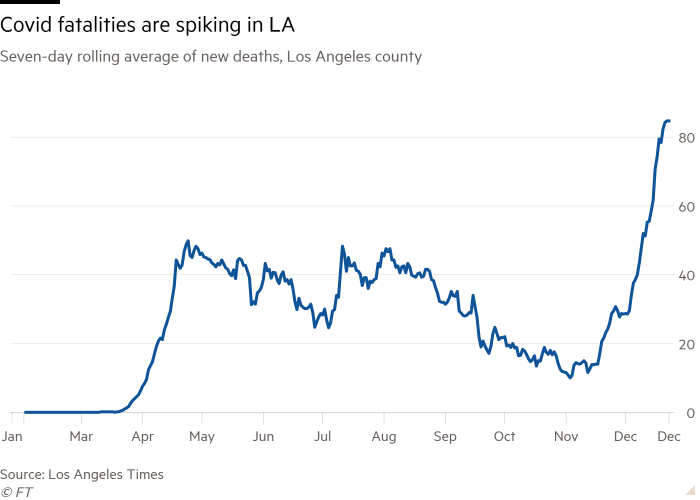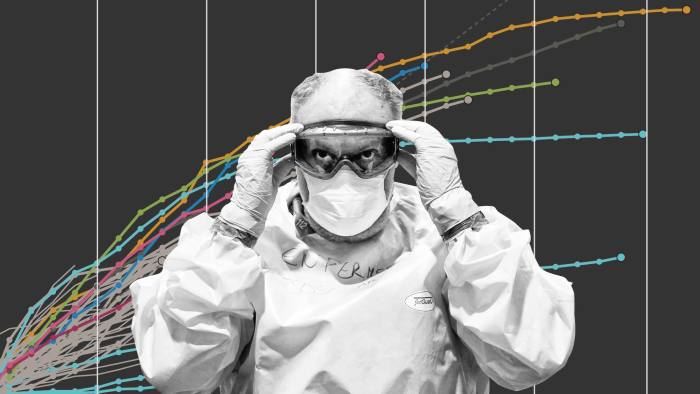In April, with California’s coronavirus rates among the lowest in the country, many of the state’s nurses flew to different parts of America to help with the pandemic. This Christmas, it is the Golden State’s hospitals that are desperate.
“You just never really know if you’re going to get enough staff,” said Valerie Ewald, who has been a nurse in the intensive care unit at UCLA’s Santa Monica Medical Center for almost 20 years.
“It’s a lot of calling and cajoling and begging,” she said. “It’s hit us and every hospital in California. But the LA area really is getting hit bad.”
California has the highest number of new daily positive cases in the US — an average of more than 40,000 cases each day over the past week, with about 250 average daily deaths over that time. On December 23 it became the first US state to surpass 2m known positive cases — with the second million cases coming in just the prior six weeks, versus 10 months for the first million.
The crisis is particularly acute in southern California where, at the time of writing, there were no ICU beds available. In LA County, the most populous in the country, the death rate over the past seven days has averaged out at more than three an hour.
“It’s a viral tsunami,” said Robert Kim-Farley, professor of epidemiology at the UCLA Fielding School of Public Health, and a former senior official at the LA Department of Public Health. “It is so much larger than we have experienced prior to this.”

The difference, he suggested, had been the combined effects of complacency, economic desperation, and the flurry of family-orientated holidays at the end of the year: Halloween, Thanksgiving, Hannukah and Christmas.
While the number of daily new cases in the state is more than 20 times higher than when lockdown orders were first enforced in April, Californians’ fear around the virus is considerably lower than it was at that time, according to University of Southern California’s Center for Social and Economic Research, which runs a bi-weekly survey assessing attitudes to the pandemic.
“People [in California] have grown less sensitive to increasing case rates, less sensitive to the risk than at the start of the pandemic,” said Kyla Thomas, a sociologist at the centre, though she noted researchers had seen the same pattern across most of the country.
Data from December 22 suggested the average perceived chance of catching coronavirus among Californians was 23 per cent, whereas it had been 30 per cent in April. The average perceived chance of dying from Covid-19 fell to 16 per cent, down from 29 per cent earlier in the year.
In LA County, the survey also suggested almost a third of respondents had visited a friend, neighbour or relative in the past week — or had people visit them.
Latest coronavirus news

Follow FT’s live coverage and analysis of the global pandemic and the rapidly evolving economic crisis here.
“If the survey is representative of LA County residents,” the health department said in a statement pleading for adherence, “more than 3,000,000 residents are not following the safety guidance that directs us to not gather with people outside our immediate household.”
As California has sought to increase treatment capacity, nursing unions have resisted state efforts to loosen the minimum requirements for the number of nurses per patient, a move medical practitioners said would significantly worsen the quality of care and put nurses at even greater risk. The California Nurses Association had held strikes opposing the move, and a number of hospitals reversed their planned changes.
More than 60,000 healthcare workers in the state have caught Covid-19, according to the California Department for Public Health, with at least 240 deaths.
“Nurses stand together, always, and we’re never afraid,” said Mendy Baxter, an emergency room nurse from Texas who has been working in California since February, first in San Antonio and more recently in Salinas. The hospital where she works — Natividad Medical Center — has erected tents outside the main building to take care of the sick.
“It’s just everything that we can do just to keep our keep our head above water,” Ms Baxter said. “The hospitals are full, the beds are full, there’s nowhere to move the patients once you get them in and start taking care of them.”
According to Aya Healthcare, a leading national contractor of “travel nurses”, as of December 21 there were 4,390 open nursing positions in California, by far the largest number in the country. Nationally, the number of vacancies for “crisis” positions has increased by more than 90 per cent in the past month. Compared to this time last year, the number of vacant nursing positions is almost 200 per cent higher.
With statewide availability of ICU beds at Christmas at just over 1 per cent, Gavin Newsom, California governor, has looked further afield, to countries such as Taiwan and Australia, to find critical care nurses, drawing on relationships created by his other 2020 crisis — wildfires.
Other moves by the governor have included emergency training — in as little as two days — to get nurses from other disciplines into the ICU. This has raised yet more concern among nursing groups, who argue that the shortage of staff was a “manufactured crisis”. Hospitals have been accused of laying off nurses and cutting pay for contractors during the “quieter” months of the pandemic.
Looking to the new year, Mr Newsom said during a press conference that the vaccination efforts made him “enthusiastic that there is light at the end of the tunnel, but mindful that we’re still in the tunnel”. Just over 70,000 people in California — mostly health workers — had received a coronavirus vaccine as of December 21.
Much of the state will be under stay-at-home orders into 2021. To deter travellers, some popular getaway destinations have shut out tourists. In Tahoe, the northern California region typically teeming with skiers at Christmas, local officials have placed additional restrictions on lodging, urging short-term rental service Airbnb to tell guests about the stay-at-home order. Airbnb said it had informed hosts of the guidelines, with any actions or refunds being at the host’s discretion.
Among those having to call off their Tahoe trip was Josh Larney, who lives in Oakland and works at WeWork. There were “definitely frustrations around the cancellation”, he said, “but that has been the story of 2020.”

